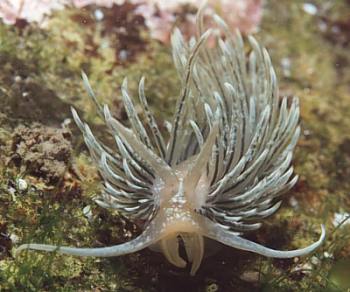
Facelina dubia
Pruvot-Fol, 1948
Order: NUDIBRANCHIA
Suborder: AEOLIDINA
Family: Glaucidae
DISTRIBUTION
Mediterranean, Atlantic Coast of Europe to Great Britain.
PHOTO
Jean-Pierre Bielecki.
May grow to 40mm long, and have relatively long oral tentacles growing to about half the body length. The rhinophores are smooth and taper to a blunt tip. The body is translucent clear with some orange pigmentation especially in larger animals. opaque white specks are scattered over the head and oral tentacles and on the tips of the tentcales and the rhinophores. There is often a large white patch between the rhinophore bases. The cerata also have white patches and a whitish tip. Thompson & Brown (1984) report it feeding on Tubularia larynx in southwestern Ireland.
Reference:
• Pruvot-Fol, A. (1948). Deux aeolidiens d'Arcachon. Journ. Conchyl. 88: 97-100, text figs 1-5
Rudman, W.B., 2002 (January 28) Facelina dubia Pruvot-Fol, 1948. [In] Sea Slug Forum. Australian Museum, Sydney. Available from http://www.seaslugforum.net/find/facedubi
Related messages
Cumanotus? from Croatia
April 19, 2005
From: Mat Vestjens
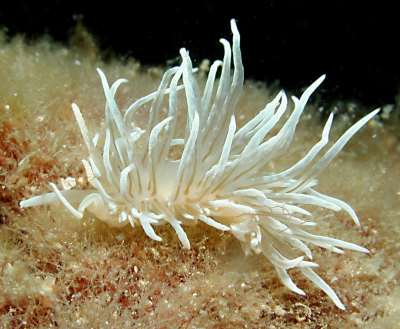
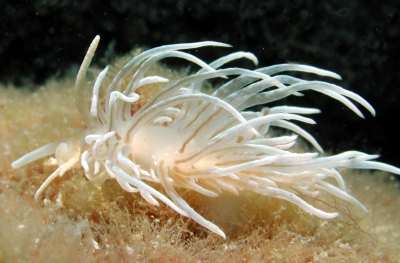
Hello Bill,
This animal is found in April 2004 in Celce, Croatia, at a depth of 4 metres. I have tried to find out what species it is, but up to this moment, nobody could help me on this. Last year your Forum was out, so I could not send it in. I have asked Bernard Picton, but he could not help me on this. I saw the message of Cumanotus on the forum and must say that this comes close.
Locality: Celse, Croatia. Adriatic sea. Depth: 4 metres. Length: 20 mm. April 2004. Photographer: Mat Vestjens.
Can you help me on this?
Best regards,
Mat Vestjens
www.natuurlijkmooi.net
annenmat@natuurlijkmooi.net
Vestjens, M., 2005 (Apr 19) Cumanotus? from Croatia. [Message in] Sea Slug Forum. Australian Museum, Sydney. Available from http://www.seaslugforum.net/find/13523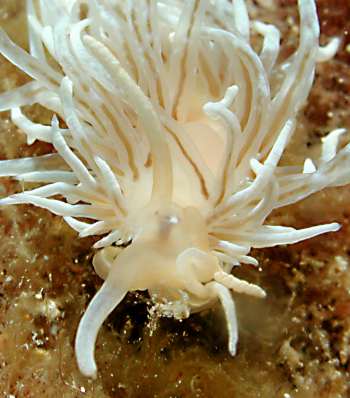
Dear Mat,
I think this is Facelina dubia. From the 'front on' view alongside, it clearly has large smoooth rhinophores, large oral tentacles, and large tentacular anterior foot corners. It looks like we may have come full circle. Tom Turk, in his first message [#13477] concerning Cumanotus, thought his species might be Facelina dubia and now you have an animal you think is Cumanotus which I suspect is Facelina dubia. A note of caution however, I have never seen this animal alive so we should wait for confirmation from someone who has.
Best wishes,
Bill Rudman
Aeolid firing its nematocysts?
January 29, 2002
From: Jean-Pierre Bielecki

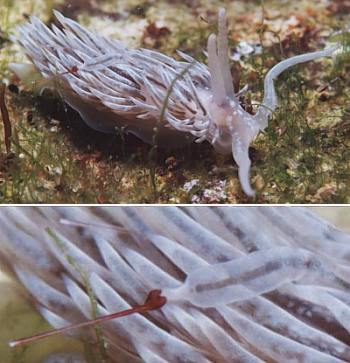
Hi Bill
Do you think that it is possible for an Aeolid to fire its nematocysts? Here are some photos of Facelina dubia, with maybe the answer. After I disturbed it, this one expelled, as a harpoon what I think to be his nematocysts. Could you please give me your thoughts about this.
Best regards
Jean-Pierre
bielecki.jeanpierre@free.fr
Bielecki, Jean-Pierre, 2002 (Jan 29) Aeolid firing its nematocysts?. [Message in] Sea Slug Forum. Australian Museum, Sydney. Available from http://www.seaslugforum.net/find/6104Dear Jean-Pierre,
To be on the safe side can someone confirm the identity of the aeolid please? It certainly looks like Facelina dubia but I am no expert on this fauna.
To your question about whether the lower photos show the aeolid firing its nematocysts - no I don't think they do. The brown object is not something being expelled from the ceras, but something that is grabbing the tip. The individual nematocysts in the cnidosac are microscopic and are diffcult to see with the naked eye. What I think these brown things are are specialised spines from a sea urchin [Echinoidea] which are called pedicellaria. Most sea urchins have small pedicellaria which are armed with 'parrot's beak'- like jaws at their tip. They are used to keep the echinoid's shell clean from organisms which would otherwise settle on the shell and smother it. In some species, the pedicellaria have become very large relative to the size of the spines and in one Indo-Pacific genus, Toxopneustes, the true spines are very small and the whole shell or test is covered with poisonous pedicellaria. I am not familiar with the Mediterranean fauna but I see in Ocana Martin et al.(2000) that at least two Mediterranean echinoids - Arbacia and Sphaerechinus have large pedicellaria like those hanging on to the cerata of your aeolid.
This is a nice photo of Facelina dubia. Could I have some locality details please?
Best wishes,
Bill Rudman
